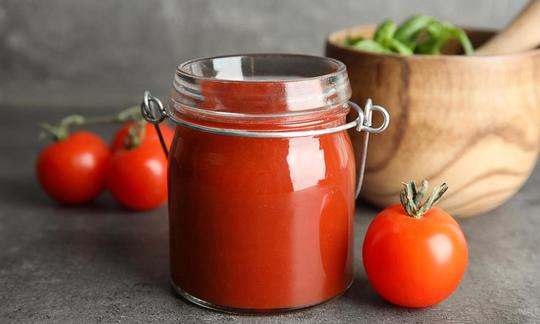Homemade Tomato Paste Made From Fresh Tomatoes
vegan
Ingredients (for servings, )
| 2 kg | Beef tomatoes, raw (organic?) (70 oz) |
Equipment
- stove
- saucepan
- skimmer
- sieve
- canning jar (Weck jar, Mason jar)
Type of preparation
- chop or grind
- sieve
- blanch
- can (bottle)
- remove the skin
- drain
- reduce (thicken)
Preparation
Making the tomato paste
Wash the beefsteak tomatoes and slice an “X” into the bottom of each one. Put them in a large saucepan with water. Bring to a boil and blanch until the skin begins to loosen.Two kilograms of tomatoes is equivalent to about 8–10 beefsteak tomatoes or 15–16 regular medium-size tomatoes.
Remove the tomatoes from the water with a skimmer and rinse briefly under cold water (or iced water).
Peel the skin off the tomatoes and remove the stems. Cut into quarters and remove the seeds.
Simmer the tomatoes for 20–30 minutes, making sure that the tomatoes don’t stick to the pan. Puree if necessary.
Place a sieve over a bowl and lay a cloth strainer like a cheesecloth (or use paper towels) in the sieve. Pour the puree into the cloth. Twist carefully to squeeze out the juice. Open the cloth from time to time and stir or shake a bit. Alternatively, leave the tomato juice to drain overnight.
You can use the drained tomato juice for other dishes.
Bottling the tomato paste
Fill the tomato paste into sterile jars and seal tightly.
Place the sealed jars in a water bath and heat to about 85 °C.
Turn the jars upside down and let cool. Store in a cool place.
|
Nutritional Information per person
Convert per 100g
|
2000 kcal | |
|---|---|---|
| Energy | 40 kcal | 2.0% |
| Fat/Lipids | 0.42 g | 0.6% |
| Saturated Fats | 0.08 g | 0.4% |
| Carbohydrates (inc.dietary fiber) | 7.8 g | 2.9% |
| Sugars | 5.0 g | 5.6% |
| Fiber | 2.6 g | 10.4% |
| Protein/Albumin | 1.9 g | 3.8% |
| Cooking Salt (Na:6.0 mg) | 15 mg | 0.6% |
| Essential micronutrients with the highest proportions | per person | 2000 kcal | |
|---|---|---|---|
| Min | Copper, Cu | 1.1 mg | 114.0% |
| Vit | Vitamin C (ascorbic acid) | 38 mg | 48.0% |
| Vit | Vitamin B9, B11 (Folate, as the active form of folic acid) | 66 µg | 33.0% |
| Vit | Vitamin A, as RAE | 198 µg | 25.0% |
| Elem | Potassium, K | 470 mg | 24.0% |
| Vit | Vitamin K | 12 µg | 16.0% |
| Vit | Vitamin B7 (Biotin, ex vitamin H) | 8.0 µg | 16.0% |
| Vit | Vitamin B6 (pyridoxine) | 0.20 mg | 14.0% |
| Vit | Vitamin E, as a-TEs | 1.6 mg | 13.0% |
| Vit | Vitamin B1 (Thiamine) | 0.12 mg | 11.0% |
Detailed Nutritional Information per Person for this Recipe
The majority of the nutritional information comes from the USDA (US Department of Agriculture). This means that the information for natural products is often incomplete or only given within broader categories, whereas in most cases products made from these have more complete information displayed.
If we take flaxseed, for example, the important essential amino acid ALA (omega-3) is only included in an overarching category whereas for flaxseed oil ALA is listed specifically. In time, we will be able to change this, but it will require a lot of work. An “i” appears behind ingredients that have been adjusted and an explanation appears when you hover over this symbol.
For Erb Muesli, the original calculations resulted in 48 % of the daily requirement of ALA — but with the correction, we see that the muesli actually covers >100 % of the necessary recommendation for the omega-3 fatty acid ALA. Our goal is to eventually be able to compare the nutritional value of our recipes with those that are used in conventional western lifestyles.
| Essential fatty acids | per person | 2000 kcal |
|---|---|---|
| Linoleic acid; LA; 18:2 omega-6 | 0.19 g | 2.0% |
| Alpha-Linolenic acid; ALA; 18:3 omega-3 | 0.02 g | 1.0% |
| Essential amino acids | per person | 2000 kcal |
|---|---|---|
| Tryptophan (Trp, W) | 0.02 g | 6.0% |
| Threonine (Thr, T, irreversibly transaminated) | 0.06 g | 6.0% |
| Isoleucine (Ile, I) | 0.06 g | 5.0% |
| Lysine (Lys, K, irreversibly transaminated) | 0.07 g | 4.0% |
| Phenylalanine (Phe, F) | 0.06 g | 4.0% |
| Valin (Val, V) | 0.06 g | 4.0% |
| Leucine (Leu, L) | 0.08 g | 3.0% |
| Methionine (Met, M) | 0.02 g | 2.0% |
| Vitamins | per person | 2000 kcal |
|---|---|---|
| Vitamin C (ascorbic acid) | 38 mg | 48.0% |
| Vitamin B9, B11 (Folate, as the active form of folic acid) | 66 µg | 33.0% |
| Vitamin A, as RAE | 198 µg | 25.0% |
| Vitamin K | 12 µg | 16.0% |
| Vitamin B7 (Biotin, ex vitamin H) | 8.0 µg | 16.0% |
| Vitamin B6 (pyridoxine) | 0.20 mg | 14.0% |
| Vitamin E, as a-TEs | 1.6 mg | 13.0% |
| Vitamin B1 (Thiamine) | 0.12 mg | 11.0% |
| Vitamin B5 (Pantothenic acid) | 0.62 mg | 10.0% |
| Vitamin B3 (Niacin) | 1.3 mg | 8.0% |
| Vitamin B2 (Riboflavin) | 0.08 mg | 6.0% |
| Essential macroelements (macronutrients) | per person | 2000 kcal |
|---|---|---|
| Potassium, K | 470 mg | 24.0% |
| Magnesium, Mg | 22 mg | 6.0% |
| Phosphorus, P | 44 mg | 6.0% |
| Calcium, Ca | 18 mg | 2.0% |
| Sodium, Na | 6.0 mg | 1.0% |
| Essential trace elements (micronutrients) | per person | 2000 kcal |
|---|---|---|
| Copper, Cu | 1.1 mg | 114.0% |
| Manganese, Mn | 0.22 mg | 11.0% |
| Iron, Fe | 0.64 mg | 5.0% |
| Zinc, Zn | 0.18 mg | 2.0% |
| Fluorine, F | 48 µg | 1.0% |
| Iod, I (Jod, J) | 2.2 µg | 1.0% |
This tomato paste is super easy to make and means you can avoid prepackaged food. It can be made from beefsteak tomatoes or regular tomatoes.
Nutrient profile: The fact that the tomatoes are reduced through cooking is not taken into account in the nutrition tables below. However, our tomato paste is five times more concentrated than regular tomatoes, meaning that you can multiply all quantities listed by approximately 5. Of course, some nutrients are particularly heat sensitive, for example, vitamin B1, vitamin B5, vitamin C, and antioxidants. Trace elements may also dissolve in water, and therefore may no longer be found in the tomato paste. You can find nutritional tables specifically for homemade tomato paste by clicking on the link to our page on Homemade Tomato Paste.
Serving size: The quantities listed make about 200 g of tomato paste — depending on how intensively you drain the tomato puree — and 200 mL of juice.
Beefsteak tomatoes: Beefsteak tomatoes are large, firm, and somewhat flat, making them ideal to use for stuffed tomatoes. In contrast to standard tomatoes, they lose relatively little juice when cut. Beefsteak tomatoes are mainly water, but they also contain vitamin A, B1, B2, C, E, niacin, and phytonutrients. The green unripe components, including the stem base, contain the toxic substance tomatidine, which is why it should be removed during preparation.
Tomato paste: Tomato paste is the concentrated pulp of ripe tomatoes that has been cooked to reduce the water content and strained. In Germany, there are three different concentrations of tomato paste that you can buy: single-concentrated (14 to 22 % dry matter), double-concentrated (28 to 30 % dry matter), and triple-concentrated (36 to 40 % dry matter). Other countries set their own standards, but you can often find double-concentrated tomato paste. Tomato paste is available in cans, tubes, and screw-top jars.
If you don’t strain the liquid from the tomato paste, you will obtain tomato puree, which has a significantly higher content of water.
Use ripe tomatoes: The riper the tomatoes, the better the tomato paste tastes in the end. For this reason, we recommend that you make tomato paste from tomatoes you have harvested yourself and that you select tomatoes that are almost overripe.
Storing tomatoes: If you buy tomatoes available at the supermarket, you should avoid storing them in the refrigerator. This goes for all tomatoes, as well as other vegetables such as peppers and eggplant, as refrigeration reduces the flavor development of the tomatoes.
A study published by The National Center for Biotechnology Information in 2016 concludes that storing tomatoes at low temperatures results in flavor loss. It found that temperatures below 12 °C have negative effects on flavor-bearing volatile organic compounds, which are significant for the flavor development of tomatoes.
Making use of the tomato juice: It would be a shame to just pour away the tomato juice that you have collected; we recommend saving it and using it for cooking.
Tomato puree instead of tomato paste: Instead of draining the tomato paste, you can also use your mixture as tomato puree. However, if recipes call for tomato paste, you will need to double the amount of paste used and reduce the liquid content elsewhere.




